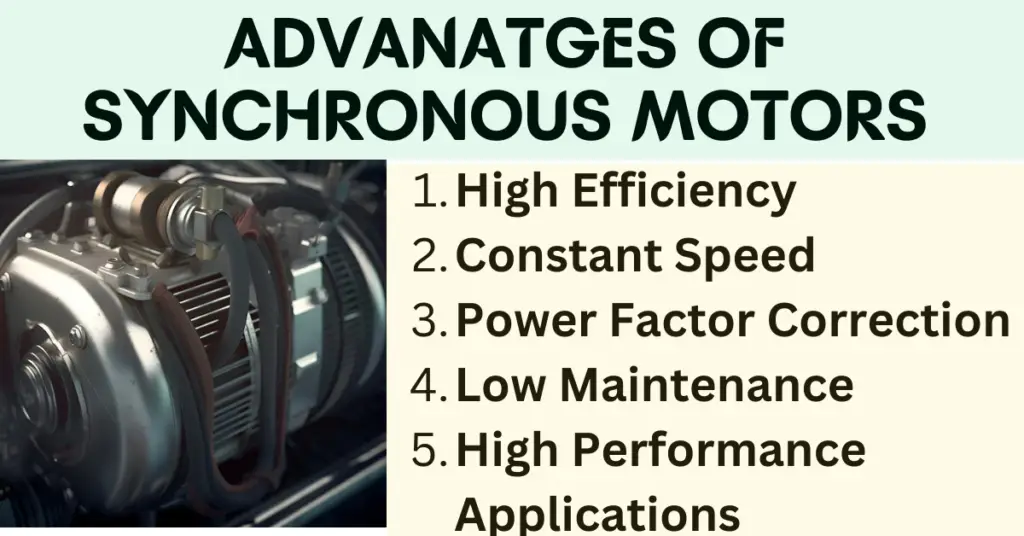The advantages of synchronous motors include constant speed, power factor control, and high starting torque. In this article, we will discuss the advantages and disadvantages of synchronous motors.
Synchronous motors are a type of AC motor that operate at a fixed speed. They are commonly used in industrial applications such as pumps, compressors, and generators.
Advantages of Synchronous Motors:

1. High Efficiency: Synchronous motors are highly efficient at converting electrical energy into mechanical energy. They have a power factor of unity, which means that they consume a minimum amount of reactive power. This makes them ideal for applications where energy efficiency is a top priority.
2. Constant Speed: Synchronous motors operate at a synchronous speed that remains constant from no-load to full load, which makes them suitable for applications that require a constant speed. They can maintain their speed even under varying loads, which makes them useful in applications such as paper mills, steel mills, and textile mills.
3. High Torque: Synchronous motors have a high starting torque, which makes them ideal for applications that require high starting torque, such as compressors, pumps, and blowers.
4. Low Maintenance: Synchronous motors have a simple and robust design, which makes them easy to maintain. They have fewer parts compared to other types of motors, which reduces the risk of breakdowns and maintenance costs.
5. Power Factor Correction: One of the major advantages of using a synchronous motor is its ability to control the power factor. An over-excited synchronous motor can have a leading power factor, which allows it to operate in parallel with induction motors and other lagging power factor loads. By doing so, it can improve the power factor of the system. By adjusting the excitation of the rotor’s magnetic field, these motors can actively manage the power factor, optimizing the overall efficiency of the electrical network. This feature is particularly beneficial for industries looking to improve their power quality and reduce reactive power charges.
6. Economical for Lower Speed Range: For applications with speeds lower than 300 RPM, synchronous motors are more cost-effective than induction motors.
7. Suitable for High-Performance Applications: Synchronous motors are commonly used in applications requiring high performance, precision, and stability. Examples include synchronous motors powering large industrial machinery, pumps, compressors, and high-precision instrumentation.
Disadvantages of Synchronous Motors:
1. High Cost: Synchronous motors are more expensive than other types of motors. This is due to their complex design.
2. Limited Speed Range: Synchronous motors have a limited speed range and cannot be used in applications that require variable speed. They require a separate device, such as a variable frequency drive, to control their speed.
3. Need for External Excitation: Synchronous motors require an external excitation source to generate a magnetic field. A DC power source provides this excitation.
4. Size and Weight: Synchronous motors are generally larger and heavier than other types of motors. This can make synchronous motors difficult to install in certain applications.
5. Need for External Prime Movers: Synchronous motors are not self-starting, and they need external prime movers to start. The methods of starting synchronous motors are external DC and induction motors (pony motors), damper winding, etc.
6. Sensitive to Load Variations: Synchronous motors can become less efficient when operating under light or variable loads. Maintaining synchronization becomes more challenging when the load fluctuates, potentially leading to a decrease in overall motor efficiency. In applications with widely varying loads, other motor types might be more suitable.
7. Potential for Hunting: Synchronous motors are susceptible to a phenomenon known as “hunting,” where the rotor oscillates around the synchronous speed. Hunting can occur under certain conditions, such as sudden load changes, and it can lead to vibrations and instability in the motor system.
Conclusion:
Synchronous motors have several advantages and disadvantages that should be considered when selecting a motor for a specific application. They are highly efficient, offer high torque, and have a constant speed, which makes them ideal for certain applications. However, they are more expensive, have a limited speed range, and require external excitation.